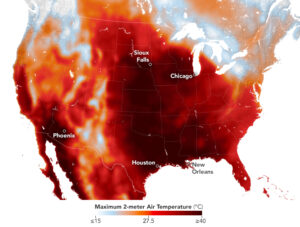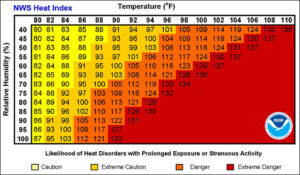The heat index (HI) indicates how hot it feels.

The HI is calculated using an equation that is a function of air temperature and the relative humidity. The HI is sometimes referred to as the “feels-like” temperature.
When our bodies get hot, we cool down by sweating. The sweating does not directly cool our bodies; it is the evaporation of the sweat that cools us down. If the air has a high humidity, then the rate of evaporation is reduced. This hampers the body’s ability to maintain a nearly constant internal body temperature.
The HI helps the National Weather Service (NWS) to determine if they should issue a weather advisory. A weather advisory is issued to bring to the public’s attention a situation that may cause some inconvenience or difficulty for travelers or people who have to be outdoors. A heat advisory is one type of weather advisory.
The NWS will issue a heat advisory when the heat index is predicted to be 100 degrees. You are then advised to limit vigorous outdoor activity and drink plenty of fluids. The NWS will initiate alert procedures when the heat index is expected to exceed 105 to 110 degrees (depending on local climate) for at least two consecutive days.
The HI is calculated assuming you are standing in the shade and there are light winds. The NWS uses the Wet Bulb Globe Temperature (WBGT) to determine the heat stress in direct sunlight, which considers temperature, humidity, sun angle, cloud cover and wind speed in its calculation.
Exposed to direct sunlight, the WBGT can be up to 15 degrees hotter than the HI. When the WBGT is high, and you have to be outside, wear a hat and lightweight, light-fitting, light-colored clothes. Drink plenty of water and take breaks in shady areas.
Steve Ackerman and Jonathan Martin, professors in the UW-Madison department of atmospheric and oceanic sciences, are guests on WHA radio (970 AM) at 11:45 a.m. the last Monday of each month. Send them your questions at stevea@ssec.wisc.edu or jemarti1@wisc.edu.


